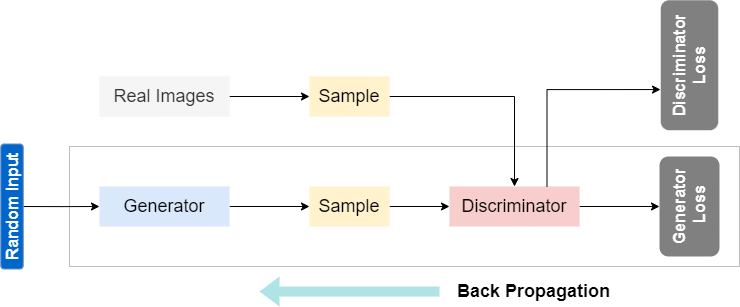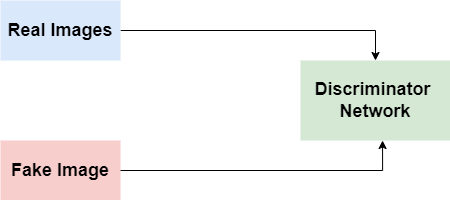What is Generative Adversarial Network (GAN)
Using convolutional neural networks, GAN is an advanced deep learning approach that finds similarities in input data so the model may create new samples that closely match the original dataset.
An effective class of neural networks for unsupervised learning is called generative adversarial networks, orGANs. They are made up of a discriminator and a generator that produce false data that are exact replicas of actual data through adversarial training. In an attempt to trick the discriminator, the generator generates high-quality samples that are random noise samples. These rivalry-based interactions propel both networks forward. GANs are flexible AI instruments that are employed in text-to-image synthesis, style transfer, and picture synthesis. By participating in a competitive interaction until the generator gets skilled at producing realistic samples, they have revolutionized generative modeling, tricking the discriminator around half the time.
What is a Generator?
A neural network that creates fictitious data to train a discriminator is called a generator in generalized autonomous networks, or GANs. It creates a sample by using an input of a random vector containing noise. Making the discriminator categorize the result as real is the primary objective.

A noisy input vector, a generator network which turns the random data into a data example, a discriminator network that categorizes the information generated, and a generator loss penalty are all included in the GAN training. In order to modify generator weights, back propagation technique modifies gradients and values.

What is a Discriminator?
A neural network called the Discriminator separates authentic data from fraudulent data produced by the Generator. During training, it employs fictitious data instances as negative instances and actual data occurrences as positive samples.

Discriminator network uses the discriminator loss and ignores the generator loss by connecting to two loss functions. The discriminator uses the Generator’s actual and incorrect information to classify during training, penalizing incorrect classifications. By using backpropagation from the discriminator loss, the discriminator adjusts its weights, resulting in an accurate categorization of real and bogus data.

How does it work?
Neural networks called GANs are made up of a Generator G(x) and a Discriminator D(x) that operate to train and learn from complicated inputs such as image, video, or audio recordings. To enhance the likelihood that the discriminator network would make mistakes, the Generator creates fictitious data samples. For instance, a GAN can determine if fifty rupee notes are authentic or fraudulent by producing fictitious notes and providing the Discriminator with authentic pictures of fifty rupee notes kept in a database. After that, the Discriminator classifies the notes as authentic or fraudulent. After the discriminator network is finished, the model is trained, computes the loss function, and backpropagates the loss into both models. To trick the discriminator into thinking that real data is bogus and vice versa is the aim.
Applications of Generative Adversarial Networks (GANs)
Produce Pictures
- GANs may provide realistic visual experiences in video games and digital media by using text-based cues or pre-existing pictures to produce realistic visuals.
- In addition, GANs may be used to edit photos, produce realistic encounters, individuals, and creatures for animation and video, and transform low-resolution photos to high-resolution pictures.
Produce Training Data for Additional Models
- Artificial information with all the characteristics of real-world data can be produced using GANs. To train another fraud-detection machine learning system, for example, they can provide false transaction data.
Insert Missing Data
- GANs are capable of precisely estimating and filling in the blanks in a dataset. For uses for energy like geothermal mapping or the storage and capture of carbon, for instance, they may produce photographs of the surface below earth, or underneath.
Create 3D Models from 2D Data
- GANs are capable of creating 3D models from scanned or 2D photographs. In the medical field, X-rays and body scans are combined to produce accurate organ pictures for surgery simulation and planning.
- Frequently utilized in text-to-image synthesis, stylistic transfer, and picture synthesis, GANs are highly adaptable artificial intelligence instruments.
Conclusion
The fundamentals and internal workings of Generative Adversarial Networks (GANs) are examined in this article. It delves into the dynamic interplay between generators and discriminators, revealing how GANs accurately discern between real and fake pictures. GAN training blends science and art as neural networks iteratively improve their tactics to generate outputs that are more lifelike. GANs may be used to create realistic photos and films, improve creative processes, and push the frontiers of digital material, among other things. The investigation also emphasizes how artificial intelligence has the power to transform the creative environment and spur innovation in a range of fields. After considering how GANs have changed the world, readers are prepared to set off on their own path of exploration, opening up new avenues and elevating AI-driven creativity to new heights.